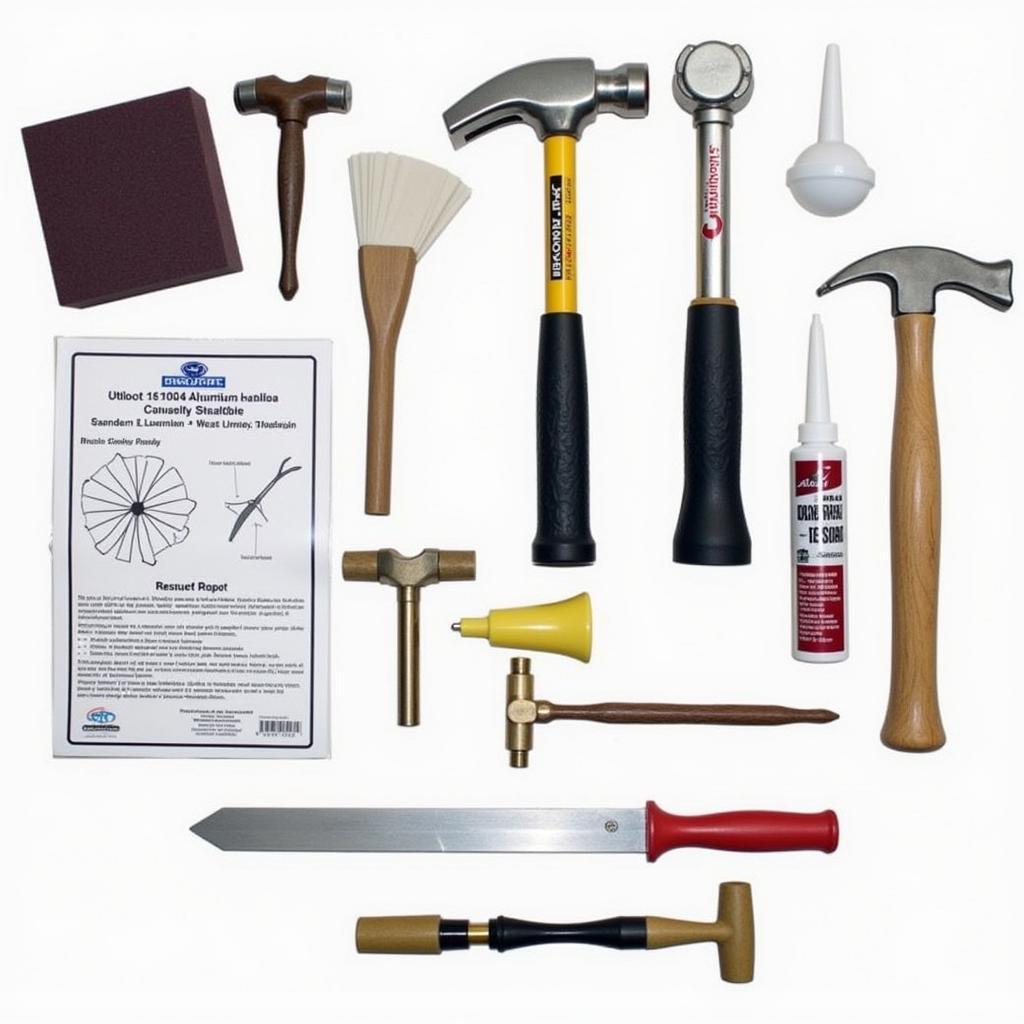A car body repairs kit for aluminium is essential for any DIY enthusiast or professional looking to tackle dents, dings, and other minor damage on their aluminium-bodied vehicle. This guide will walk you through everything you need to know about choosing, using, and maximizing the effectiveness of your aluminium car body repair kit.
Understanding the Importance of Aluminium Repair
Aluminium has become increasingly popular in car manufacturing due to its lightweight nature and improved fuel efficiency. However, repairing aluminium requires specific tools and techniques compared to traditional steel bodywork. Using a dedicated car body repairs kit aluminium ensures you have the right equipment to achieve a professional and long-lasting repair.
Why Choose an Aluminium Car Body Repair Kit?
- Specialized Tools: Aluminium requires specialized tools that won’t damage the softer metal. These kits often include tools like specialized hammers, dollies, and sanding blocks.
- Corrosion Prevention: Aluminium is prone to corrosion. A proper repair kit will include products that prevent corrosion and ensure the longevity of the repair.
- Specific Fillers and Adhesives: Aluminium requires specific fillers and adhesives that are compatible with the metal and provide a strong, durable bond. Generic body fillers won’t work effectively.
 Aluminium Car Body Repair Kit Essential Tools
Aluminium Car Body Repair Kit Essential Tools
Choosing the Right Car Body Repairs Kit Aluminium
Selecting the correct car body repairs kit aluminium can seem daunting, but understanding your needs and the available options simplifies the process. Consider the following factors:
- Extent of Damage: For minor dents and scratches, a basic kit might suffice. More significant damage may require a more comprehensive kit with advanced tools and fillers.
- Your Skill Level: Beginner kits often come with detailed instructions and simpler tools. Experienced users might prefer kits with more specialized equipment.
- Budget: Aluminium repair kits range in price depending on the tools and materials included. Consider your budget and the frequency of use when making your decision.
Key Components of an Aluminium Repair Kit
- Stud welder: Essential for pulling out dents without damaging the surrounding area.
- Aluminium body filler: Specifically designed to adhere to aluminium and provide a smooth, paintable surface.
- Epoxy adhesive: Provides a strong bond for structural repairs.
- Sanding tools: Various grits of sandpaper and sanding blocks are necessary for smoothing the repaired area.
- Corrosion inhibitor: Protects the repaired area from future corrosion.
“A quality aluminium repair kit is an investment that will save you money and headaches in the long run. It’s crucial to have the right tools and materials to achieve a professional and lasting repair,” says Jake Thompson, Lead Automotive Technician at Thompson Auto Repair.
Step-by-Step Guide to Using Your Aluminium Car Body Repairs Kit
Once you’ve chosen the right kit, follow these steps to effectively repair aluminium car body damage:
- Clean the Damaged Area: Thoroughly clean the area with a degreaser and ensure it’s free of dirt and debris.
- Assess the Damage: Determine the extent of the damage and the appropriate repair technique.
- Remove Loose Paint and Rust: Carefully remove any loose paint or rust using a sanding tool.
- Apply the Stud Welder (if needed): If the dent requires pulling, use the stud welder to attach pulling studs and gently pull the dent outwards.
- Apply Aluminium Body Filler: Apply the aluminium body filler according to the manufacturer’s instructions, ensuring a smooth and even surface.
- Sand and Smooth: Once the filler dries, sand the area smooth using progressively finer grits of sandpaper.
- Apply Primer and Paint: Apply a primer specifically designed for aluminium and then paint the repaired area to match the original car colour.
Maintaining Your Aluminium Car Body Repairs Kit
Proper maintenance ensures the longevity and effectiveness of your car body repairs kit aluminium.
- Clean Tools After Use: Remove any residue from tools after each use.
- Store Properly: Store the kit in a dry and cool place to prevent corrosion and damage to the tools and materials.
- Check Expiration Dates: Regularly check the expiration dates of fillers and adhesives and replace them as needed.
Conclusion: Achieving Professional Aluminium Car Body Repairs
A car body repairs kit aluminium empowers you to tackle minor to moderate damage on your aluminium vehicle effectively. By choosing the right kit, following the correct procedures, and maintaining your tools, you can achieve professional-looking results and extend the life of your vehicle. Remember to always prioritize safety and consult a professional if the damage is extensive or beyond your skill level.
FAQ
- What’s the difference between steel and aluminium body filler?
Aluminium body filler is specifically designed to adhere to aluminium and resist corrosion. Steel body filler is not compatible with aluminium. - Can I use a regular stud welder on aluminium?
No, you should use a stud welder specifically designed for aluminium to avoid damaging the metal. - How long does aluminium body filler take to dry?
Drying times vary depending on the product and environmental conditions, but generally, it takes between 20-30 minutes. - What type of primer should I use on aluminium?
Use an etch primer specifically formulated for aluminium to ensure proper adhesion of the paint. - Can I repair major structural damage with a DIY kit?
For major structural damage, it’s best to consult a professional auto body repair shop. - How do I prevent corrosion after repairing aluminium?
Using a corrosion inhibitor and ensuring a proper seal with paint will help prevent future corrosion. - Where can I buy a car body repairs kit aluminium?
You can purchase these kits from automotive parts stores, online retailers, or specialized tool suppliers.
Need further assistance? Contact us via WhatsApp: +1(641)206-8880, or Email: [email protected]. Our 24/7 customer support team is ready to help.
